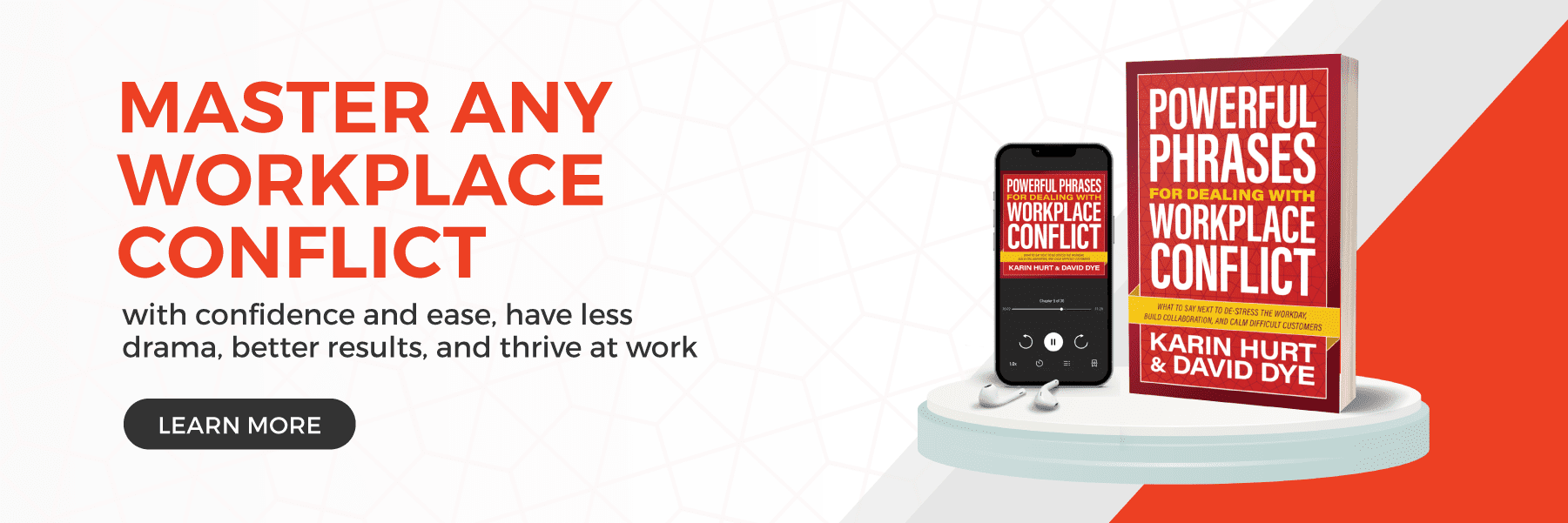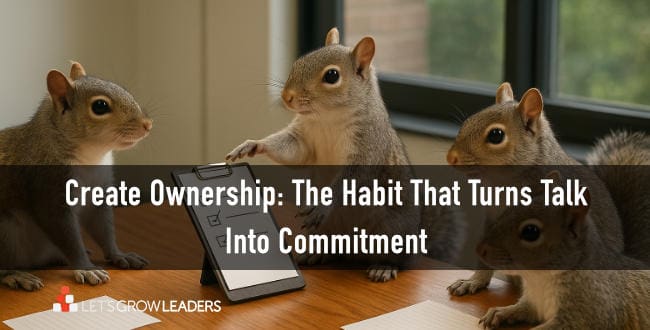Effective leaders hold meetings that get results and people want to attend
Horrible meetings are a cliché of the business world and with good reason. Too many meetings are a waste of time and don’t accomplish anything. Minutes creep along while the meeting leader fritters away everyone’s time, people have meaningless conversations that don’t solve problems, and everyone is frustrated that they could be doing something more productive with their time. If the meeting happens online, people multitask (or wish they could).
When you don’t run meetings well, not only do your results suffer, so does your credibility.
But bad meetings, while a cliché, aren’t inevitable. In fact, we maintain that people don’t hate meetings. They hate bad meetings – those soul-sucking wastes of time. There are six ways you can ensure your meetings are effective and energizing:
- Don’t Waste Their Time
- Know Your Outcomes
- Get the Right People in the “Room”
- Clarify Intent
- Clarify Who Owns the Decision
- Turn Meetings into Results
Six Advanced Techniques to Lead Meetings That Get Results and People Want to Attend
1. Don’t Waste Their Time
Let’s begin with one of the biggest reasons people hate meetings. They abuse our most precious resource: time.
Effective leaders treat everyone’s time as a precious resource. Starting and ending on time is a basic meeting skill – when you carelessly let meetings run long or start late, or have a meeting you never should have called, you disrespect your people.
The advanced technique to avoid wasting people’s time is to hold meetings only when they are the most valuable use of all the attendees’ time. If there is something employees could do that is more valuable, that contributes more directly to the team and to the results you’re trying to accomplish, why on earth would you want them in your meeting where they are less productive?
2. Know Your Outcomes (Relationships and Results)
So how do you make sure a meeting is a good use of time?
Start with purpose. What outcome will this meeting achieve? How will it help the people who attend to achieve results and build relationships?
Outcome: Results
Your meetings should also move the mission of your group, team, and organization forward. In short, meetings should produce action. You got together to solve a problem, make a decision, or share information, and when the meeting ends, it’s time to do something. If your meetings don’t result in clear action, you’ve wasted your time.
Outcome: Relationships
Business results often take center stage, but relationships are also a critical outcome of effective meetings – especially for teams who work virtually or in a hybrid environment.
Teams require trust, and that’s built only through time spent together, solving problems, making decisions, and learning how everyone operates, sees the world, and shares information. In addition to the connections built through working together and solving problems, you can also include periodic conversations that build relationships, such as:
- Cultural conversations to problem solve or celebrate: for example, “What’s really getting in the way of people using our new system?” or, “What have you seen another member do well over the last month?”
- Elephant-in-the-room conversations: for example, “What are the conversations we’re not having that we should be having?”
- Mutual-help conversations: for example, “Let’s talk about how we’re working with other departments. What’s working well? Where do we have challenges?” Give people a chance to share and help one another.
These conversations can happen quickly and be a rich source of positive relationships and results as your people learn to trust each other and help one another.
Effective teams meet frequently. You want to be certain the meetings you hold are effective and that they are the best use of every attendee’s time. This will happen when you focus every meeting to build relationships and achieve results. If your meeting isn’t going to build relationships and advance the mission of the organization, don’t have the meeting.
3. Get the Right People In the “Room”
Who should attend a meeting?
You want the smallest number of stakeholders that will allow you to make the best decision. Think about the number of people in your meeting as a continuum. On one end, you could hold the meeting with just yourself. It might look funny, but you could sit there by yourself, examine what you know, make a decision, and then share the decision with everyone else.
On the other end of the continuum, you could have everyone—every single person in the organization—attend a meeting. If you have a 50-person organization, all 50 of them would attend, and that would be unwieldy, but if you work in a 10,000-person organization, it would be impossible.
So, the question is, what is the smallest number of people who can attend but still provide you with good, diverse, and informed input from those who have a stake in the decision?
Where most leaders go wrong is that they invite too many people who have the same perspective and fail to invite key representatives with different vantage points who might help them make a better decision if they had input – particularly people affected by the decision.
Remember, the goal of most meetings is to take action. When you take people away from their normal work, you do it so that all of you together can make a better decision than you would have done on your own. You’ll waste everyone’s time if you don’t invite the necessary people to the meeting.
4. Clarify the Intent
What kind of meeting are you leading?
There are several types of meetings, but we’re going to focus on the two most common ones.
The first type is the informational meeting.
These are short meetings to exchange information. The key to an informational meeting is that there is an exchange of information (not just information going in one direction).
It’s not you pulling people together because it’s more convenient for you.
Remember, the meeting needs to be the most valuable use of their time as well. This can happen if there is an honest exchange, an opportunity to ask questions, and interaction around the information being shared, and the meeting is brief.
The second type of meeting exists to make decisions and act.
Most of your meetings should fall into this category. They can be anywhere from 15 minutes to two hours long and feature a specific decision to make or a problem to solve (a problem is just a specific kind of decision).
The key to making meetings work for you and your team is to be very clear about what kind of meeting you’ve called. When you mix up an information exchange with decision-making, it frustrates everyone.
If you want to solve a specific problem, don’t allow a team member to turn the meeting into a briefing on her latest project unless it specifically helps the group solve the problem at hand. Stay focused on the specific objectives for the meeting you’re leading.
5. Clarify Who Owns the Decision
“This is so stupid—you asked for my opinion and then ignored it. I don’t know why I even bother! From now on, I’m just going to shut my mouth and do my work.”
If you’ve heard this or said it yourself, you’ve experienced a lack of clarity around decision ownership.
People hate feeling ignored. Unfortunately, when you ask for input and appear to ignore it, employees feel frustrated, devalued, and powerless. In contrast, when you are clear about who owns the decision and how it will be made, people will readily contribute and are far more likely to own the outcome.
This isn’t difficult to do because there are only four ways to make a decision:
- A single person makes the decision.
Typically, this would be the manager or someone she appoints. In this style of decision-making, you might ask your team for input and let them know that after hearing everyone’s perspective, you will make the decision.
- A group makes the decision through a vote.
This might be a 50-percent-plus-one majority or a two-thirds majority, but in any case, it’s a decision by vote. With this option, you ask everyone to contribute input, and they know that the decision will be made by a vote at a specific time.
- A team makes the decision through consensus.
Consensus is often misunderstood. Consensus decision-making means that the group continues discussion until everyone can live with a decision. It does not mean everyone got his or her first choice, but that everyone can live with the final decision. Consensus decision-making can take more time and often increases everyone’s ownership of the final decision.
- Let fate decide.
Though it’s rarely used in business settings, you can flip a coin, roll the dice, or draw from a hat. When time is of the essence, the stakes are low, and pro-con lists are evenly matched, it’s often good to just pick an option and go. For example, if you have 45 minutes for a team lunch, it doesn’t make any sense to spend 30 minutes discussing options. Narrow it down to a few places, flip a coin, and go.
Each way of deciding has advantages, but what’s most important is to be very clear about who owns the decision.
The person who said, “You asked for my opinion and then ignored it. I don’t know why I even bother!” was under the impression that the team would decide by vote or consensus when in reality it was the leader’s decision. This type of confusion wastes tons of precious time and energy.
Instead, before the discussion begins, state how the decision will be made.
Be specific. For example, you might begin a decision-making session by saying, “Okay, I’d like to spend the next 40 minutes getting everyone’s input, and then I’ll make the decision.” Or, you might describe the decision to be made and say, “We’re not going to move forward until everyone can live with the decision.”
You might even combine methods and say, “We will discuss this decision for 30 minutes. If we can come to a consensus by then, that would be great. If not, we’ll give it another 15 minutes. After that, if we don’t have consensus, I’ll take a final round of feedback and I’ll choose, or we’ll vote.”
You’ll avoid wasted energy, energize, and empower your people to be more influential because when they know who owns the decision, they also know how to share their information. Do they need to persuade the single decision maker, a majority, or the entire team? They can choose their most relevant information and arguments.
6. Turn Meetings into Results
Does this scenario sound familiar? You went to a meeting where you had invigorating discussions, examined alternatives, and came up with a cool plan of action; everyone left the meeting feeling motivated, and then six weeks later you got back together. As everyone entered the room and took their seat, there were sideways glances.
“Did you do that thing we talked about?”
“No, how about you?”
A quick shake of the head and you realized that the great idea everyone talked about had languished.
The prior meeting, the discussions, the new meeting—all of it— were a waste because nothing happened. In fact, it’s worse than doing nothing because now you’ve created negative energy, that feeling that, “It doesn’t matter what we talk about because nothing really changes around here.”
Every meeting you hold should produce activities that move results forward, build momentum, and build morale with healthy relationships. You can achieve all this in just five minutes at the end of every meeting.
Let’s begin with mindset. We invite you to think about meetings as commitment creators. In other words, the outcome for every decision-making or problem-solving meeting you ever have is to create commitment.
You get the right people together to discuss the problem, you make a decision, and people commit to doing something. The product of a good meeting is a commitment to activity. You build this commitment with three questions to schedule the finish.
Commitment 1: Who Will Do What?
Until someone actually does something, nothing has changed from before you made the decision. Until then, it is just a nice idea.
Every task needs a specific person who is responsible to complete it. For smaller decisions, there might be only one or two answers to this question. For larger, strategic initiatives you might have an entire work plan that outlines dozens of tasks and people responsible.
Commitment 2: By When?
This one is straightforward. What is the finish line for the tasks people have agreed to complete? When these deadlines are shared and publicly available, everyone is more likely to meet them.
Commitment 3: How Will We Know?
Pablo shrugged, “Linda, I did those updates. I don’t see why you’re so upset.”
Linda’s team had decided to launch a new product that involved many moving parts. They had clearly answered the first two questions: Who does what and by when? For the most part, everyone kept to their commitments, and yet the delivery date kept slipping.
When Linda investigated, she discovered that individuals had done what they’d said they would do, but there was still something missing. Linda and other team members couldn’t always take the next step until another person had finished her piece. Pablo had finished his piece but never let anyone else know. He had moved onto other work, diligently crossing items off his to-do list while the overall project sat idle.
In big projects you may have a project manager or a project management tool to ensure that this type of next-step communication happens, but what about in your more ordinary, day-to-day meetings? Where is the accountability?
“How will we know?” is the magic question that moves your meeting from good intentions to action and results. It’s also the one that leaders most frequently ignore.
“How will we know?” closes the loop from intention to action and creates momentum without you having to spend hours every day tracking down action steps.
Here’s how it works: When someone completes a task, what do they do next?
- Will they pass the results to another person or group?
- Should they update the team and let them know?
- Will they make a presentation of his findings?
- Do they report completion in a common area or software?
The specific answers depend on the task and project. What matters is that the accountability and next step are baked into the decision. Everyone knows what they are accountable to do, the team knows if it’s been completed, and no one is left waiting around for the information she needs.
Don’t let the simplicity of these questions fool you into not using them. We’ve seen thousands of managers struggle and get frustrated because they didn’t ensure this kind of clarity at the end of every meeting. These are the most important five minutes you’ll spend to make your meetings achieve results.
Your Turn
These six strategies go beyond traditional (and true) meeting advice to have an agenda or start and end on time. Use these techniques to ensure you lead meetings that get results and people want to attend.
We’d love to hear from you – what is your number one way to ensure a meeting is productive and energizing?
You Might Also Like:
- Leading Remote Teams Resource Center
- Leadership Skills: 6 Competencies You Can’t Lead Without
- 101 Remote Team Communication Approaches for Stronger Teams
- 6 Habits of Highly Successful Virtual and Hybrid Teams









0 Comments